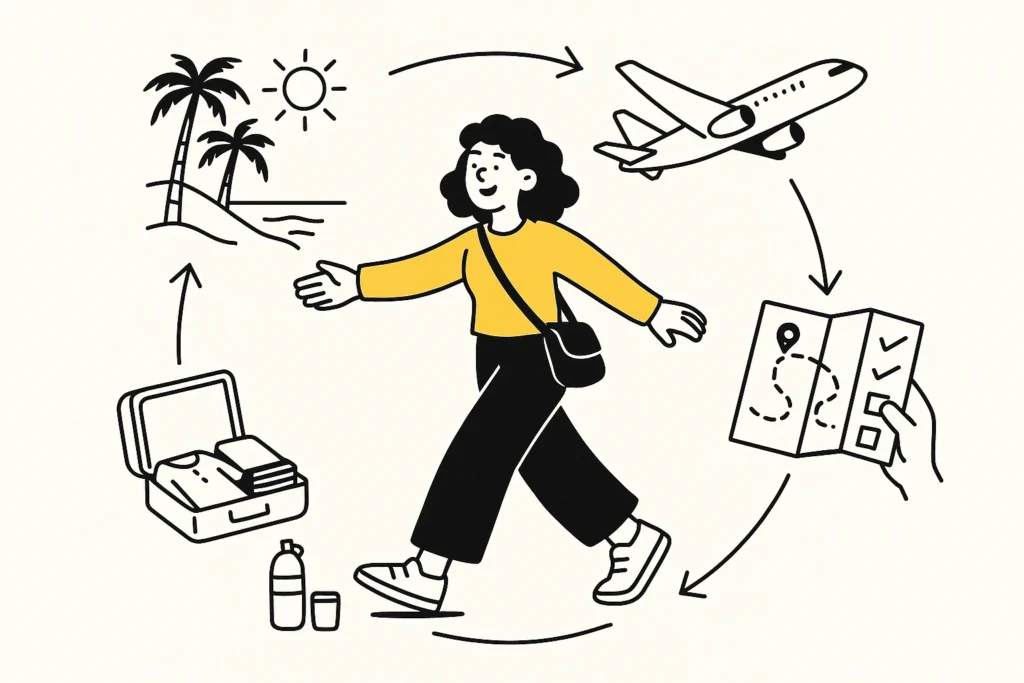
Planning a trip should be enjoyable—not a part-time job.
But seriously, with airfare, lodging, packing, and the paralyzing “what do we even do there?” element, it can get out of hand in a hurry.
The bright spot? Planning a trip isn’t something you need to stress about. With five simple steps, you can turn that vacation dream into reality. Ready? Let’s go!

A playful doodle illustration showing the cycle of trip planning: from choosing a destination, booking transport, and creating an itinerary, to packing bags.
Step 1: Pick Your Destination (A.K.A. The Fun Part 🌍)
And here we begin an adventure! Do you want to:
Unwind on a beach with a mocktail?
Walk where Wi-Fi does not reach?
Explore a lively city of street food and culture?
Your time, your budget, and your travel style will guide the decision.
👉 Pro tip: Still stuck? Ask a travel agency like Tailwinds Travels. They can suggest the perfect package (and even take care of the boring details like visas and transfers).
Step 2: Decide How You’re Getting There ✈️🚆🚗
Flights, trains, buses, road trips—the choice is yours.
Flying? Book early and stalk those midweek deals.
Road-tripping? Make sure your car (or rental) is road-ready.
Train or bus? Book in advance so you don’t end up with the dreaded middle seat.
Not in the mood for dealing with bookings? Travel agents have a habit of bundling transport into neat little packages—no fuss, no danger.
Step 3: Find Your Dream Stay 🏨
Where you stay can or should break or make the mood. Do you want:
A high-end resort with infinity pools?
A cozy B&B that’s home from home?
A budget-friendly hostel where you make new friends?
Sites such as Airbnb and Booking.com are wonderful for searching, but travel operators tend to get perks such as discounts, complimentary breakfasts, or extended checkouts.
👉 Tip: Search for free-cancellation stays. Things change—better safe than sorry!
Step 4: Create an Itinerary (But Leave Space to Breathe) 📅
It’s now time for the puzzle of planning: what, where, and when to eat, see, and do.
Create a list of absolute must-sees (hi Eiffel Tower).
Throw in some insider advice (TripAdvisor and travel blogs are your BFFs).
Include some chill time (because who needs a holiday that’s a marathon?).
Spreadsheets and maps not your cup of tea? Many agencies have pre-designed itineraries or customized ones to match your vibe—so you experience the pleasure without the hassle of planning.
Step 5: Pack Like a Pro 🎒
Packing doesn’t have to be a nightmare.
Start with essentials: passport, visa, insurance, chargers.
Dress smart: pack versatile clothes that mix and match.
Travel light: baggage fees = money better spent on souvenirs.
Use packing cubes (trust us, they’re life-changing).
And don’t forget a small carry-on with snacks, water, and a change of clothes—you’ll thank yourself after a long flight.
Wrapping It Up
See? Planning a trip isn’t rocket science. With five easy steps—destination, transport, stay, itinerary, and packing—you’re all set for a smooth, fun-filled adventure.
And besides, if it still looks like too much to handle, let the professionals do it. At Tailwinds Travels, we take care of the logistics (flights, hotels, tours, even visas) so you can focus on what matters: enjoying your trip.
Safe travels and happy adventures!
